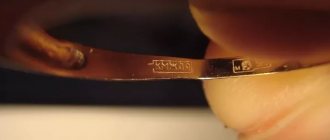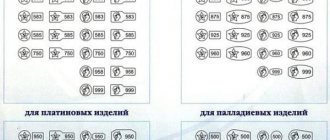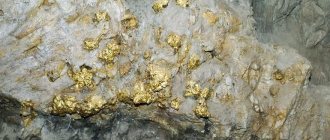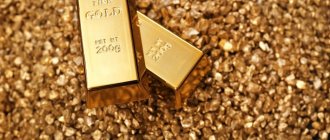Gold is an invariably sought-after symbol of wealth and luxury, an object of desire and the meaning of life for representatives of many generations.
Discovering a “gold mine” that can solve material problems in an instant is considered a rare success and the dream of almost every person. How to find gold? Finding your “piece of happiness” is almost impossible due to its inaccessibility. The location of the precious metal is known only to a few initiates, although gold is truly quite widespread in nature. Present almost everywhere (in animal and plant organisms, in water and soil), it is in such an insignificant concentration and fragmented state that its presence can be felt only through logical thinking and deep knowledge.
From the point of view of physics and chemistry, gold is a good conductor of heat and electricity, as well as a ductile metal with a high degree of malleability, capable of transforming it into a product thinner than a human hair. Everyone knows what gold jewelry looks like, as well as the fact that in the jewelry industry, high-quality products are formed in alloys with copper, silver and nickel, which give the product the necessary strength.
How gold was formed
There are several versions of the origin of gold.
One of them claims that the result was a massive fall of celestial objects containing this metal, which, having fallen inside the earth’s crust, was distributed in it and gradually penetrated to the earth’s surface due to volcanic activity.
The second version, the most common, suggests that gold was originally part of the matter that formed the Earth.
In any case, gold is formed as a result of changes occurring deep in the earth's crust at high temperatures and enormous pressure.
Areas of significant accumulation of industrially mined gold are called deposits. Gold can also be found in placers and small deposits.
A little history
Because gold could be found almost anywhere in the world, it became an essential element in almost all human cultures.
Starting with Ancient Egypt, where decorative gold objects dating back over 5,000 years have been found. Advertising - Continued below
The beauty of gold was associated by ancient people with immortality and the wealth of the gods, so jewelry and decorative elements were made from it. Gold was also one of the first currencies to replace traditional barter exchange.
Children's gold bracelet. Egypt. Approximately 2650 BC Photo: www.metmuseum.org
The very first gold coins were minted in the kingdom of Lydia in 550 BC, and since then this metal has remained the main element of the monetary system. Even after modern paper money was adopted, currencies remained linked through the Gold Standard, a system introduced in the 1870s that fixed the value of these currencies in a certain amount of gold.
Types of deposits
According to their type, deposits, which are quite rare, are divided into 2 types: primary and secondary.
- Primary deposits
Indigenous (primary). They arise in connection with ongoing natural processes and are found mainly in mountainous areas. During volcanic activity, flows of magma containing alloys of its own compounds, minerals of the earth's crust and water erupt to the surface along faults and cracks, where they cool down after some time. This leads to their disintegration and the appearance of quartz veins containing gold. Moreover, the precious metal is presented in the form of tiny grains, invisible to the naked eye, and quantitatively depends on the conditions of formation of quartz veins and their chemical composition.
- Metals in alloys with gold
Gold is usually found in alloys with metals such as silver, platinum, copper, zinc and lead. Moreover, in the process of identifying it, an interesting relationship is visible: deposits with a significant silver content are scarce in the required gold, and vice versa: gold-bearing sources cannot boast of silver in sufficient quantities.
Some gold is mined as an accompanying metal in the development of mines containing silver, lead, copper, nickel, zinc and platinum group metals.
Primary gold deposits were formed in several ways, but were always associated with igneous rocks. The development of primary deposits for the most part occurred in the 20th century, in which the emergence of new technologies for extracting gold from ore led to an active search for gold-bearing mines. Geographically, primary deposits are most often located in the bowels of the Earth and require a mine mining method.
- Secondary deposits
Placer (secondary). Most often they are located closer to the surface, along the flow of rivers, but can be hidden under significant layers of waste rock. The formation of secondary deposits is caused by the destruction of rocks containing initial formations of gold. This process is directly influenced by factors of a physical and chemical nature: groundwater, temperature changes, precipitation, and the activity of microorganisms. Water, which plays a significant role in the movement of released gold, over time erodes rocks and carries broken pieces down, crushing them into smaller pieces during movement. Since gold is one of the heaviest metals, it, without reacting with water, can accumulate in uneven terrain formed by the terrain, at the bottom of rivers and other bodies of water, from where it is later mined.
Secondary deposits are varied (by geographical location, size and method of formation) and can be destroyed, promoting the migration of gold and the new formation of placers. Placers can occur due to changes in the natural landscape, in the event of destruction of primary deposits.
A rich placer can be formed by the accumulation of gold from several veins in one space.
What does gold look like?
Placer gold generally does not need to be extracted from solid ore, making it readily available. Therefore, efforts to discover it mostly involve searching for alluvial deposits, since the extraction of precious metal in them is much simpler and is carried out by removing a layer of waste rock covering the placer.
The discovery of large gold nuggets is considered lucky—beautiful, miraculous works of nature, which are quite rare. There are only a few dozen of them in the world, and each has its own unique name. The most substantial nugget in Russia weighing more than 36 kg was discovered in the Urals in 1842. And the champions of champions are the Australian nugget from 1869, weighing 70.9 kg with a gold content of 69.6 kg, and a huge block called the “Holtermann Plate”, weighing 235.14 kg with 82.11 kg of pure gold in it, found in 1871.
What most of the remaining nuggets look like is unknown to history, since many of the ingots were subjected to melting, a process that is disastrous for such works of art.
PROPERTIES
Gold bars and nuggets
Gold is a very heavy metal: the density of pure gold is 19.32 g/cm³ (a ball of pure gold with a diameter of 46.237 mm has a mass of 1 kg). Diamagnetic, that is, the magnetic field in gold weakens. Among metals, it ranks seventh in density after osmium, iridium, rhenium, platinum, neptunium and plutonium. Tungsten has a density comparable to gold (19.25). The high density of gold makes it easier to extract, which is why even simple technological processes - for example, washing at sluices - can provide a high degree of gold recovery from the washed rock. Gold is a very soft metal: hardness on the Mohs scale is ~2.5, on the Brinell scale 220-250 MPa (comparable to the hardness of a fingernail). Gold is also highly ductile: it can be forged into sheets up to ~0.1 µm (100 nm) thick (gold leaf); With such a thickness, gold is translucent and in reflected light has a yellow color, in transmitted light it is colored bluish-greenish, complementary to yellow. Gold can be drawn into wire with a linear density of up to 2 mg/m. The melting point of gold is 1064.18 °C (1337.33 K), boils at 2856 °C (3129 K). The density of liquid gold is less than solid gold and is 17 g/cm3 at the melting point. Liquid gold is quite volatile and actively evaporates long before its boiling point.
Digital statistics of gold mining
History has recorded the richest accumulations of ore and placer gold containing 100 grams or more of precious metal per ton of rock. Small areas were marked with kilogram gold grades per tonne of ore.
Modern mines are considered rich if there are more than 10 grams of gold per 1000 kg of ore, and a profitable rate is 4-5 grams per thousand kilograms. Profitability and material justification, in addition to the specific gravity of gold in the rock, are determined by such indicators as the depth of ore veins, the nature of the rock, transport conditions, and development of the territory.
By the way, the first discoveries of the precious metal were in alluvial deposits: People discovered small nuggets in river beds and on the banks of streams. Gold rushes in Alaska, Australia and California are associated with placers; in the 19th century, such deposits accounted for 90% of the world's gold. This figure fell steadily throughout the 20th century, reaching 2% in 1971. Recently, the percentage has increased slightly due to the revival of gold mining in old (even abandoned) mines and new locations. This is especially true for Colombia, Brazil and a number of other countries.
If we consider natural gold reserves by country, the United States takes 1st place, with 59 deposits with gold reserves of more than 13 thousand tons; followed by Canada and South Africa with similar indicators; Russia ranks 4th with gold production of more than 9 thousand tons from 33 deposits.
PHYSICAL PROPERTIES
| Mineral color | rich yellow, fading to white-yellow with a predominance of silver |
| Stroke color | brilliant yellow |
| Transparency | opaque |
| Shine | metal |
| Cleavage | No |
| Hardness (Mohs scale) | 2,5-3 |
| Strength | malleable |
| Kink | jagged |
| Density (measured) | 15 - 19.3 g/cm3 |
| Radioactivity (GRapi) | 0 |
| Magnetism | diamagnetic |
How deposits are developed
Finding gold is very difficult; its extraction is an art. There are no special indicators that can accurately determine its presence in rocks. Therefore, when searching for gold, a thorough study of the area, a deep understanding of geology, observation, accumulated experience, knowledge of modern exploration methods and, of course, intuition are required.
Along with the exploration of mineral territories, special attention must be paid to the percentage of gold in the total mass of ore in order to understand the economic efficiency of the developed deposit. Profitability will be fully justified if its satellites, other minerals, are mined with gold.
Assessing the world's current gold reserves requires a global approach. This means taking various rock samples, carrying out repeated calculations regarding the profitability of gold mining, and performing drilling and geological exploration work on a significant scale.
Here is an example of preparing a field for production:
- primary reconnaissance, covering the search and assessment of lands, as well as establishing the order of their transfer in subsequent preparatory phases;
- target survey to delineate the mine boundaries;
- preliminary engineering work;
- taking metallurgical samples;
- carrying out economic calculations and methods of probable analysis;
- rental or acquisition of land plots with fossil gold;
- preparatory work for the transfer of the deposit to industrial development using complex, state-of-the-art equipment.
Upon completion of exploration and preparation of the deposit for industrial work, the construction of a gold mining enterprise begins. The construction of a modern gold mine can cost half a million dollars, taking into account capital costs and the number of employees, the number of which ranges from 15-20 thousand people.
The annual gross output of the newly formed enterprise is approximately 40 tons of metal, which in monetary terms is equivalent to 500 million dollars.










